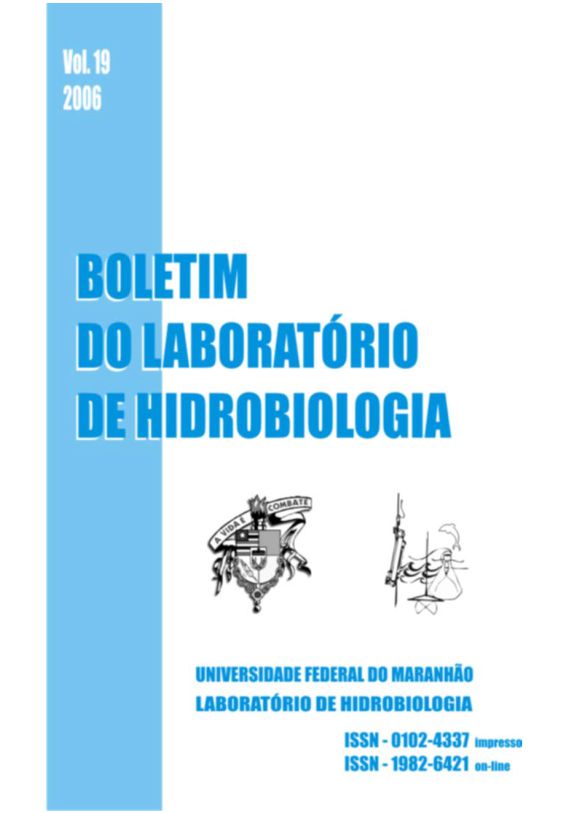Ontogenia da Tolerância à Salinidade do camarão Peneídeo: Farfantepenaeus paulensis (Pérez-Farfante,1967)
DOI:
https://doi.org/10.18764/Palavras-chave:
salinidade, ontogenia, F. paulensis.Resumo
A tolerância à salinidade foi estudada em larvas e pós-larvas do camarão marinho da espécie, Farfantepenaeus paulensis (Pérez-Farfante, 1967). Nesta espécie, a tolerância à salinidade aumenta através dos estágios larvais. A primeira larva do camarão, o náuplio, é estenohalino, através da metamorfose, esta larva, vai-se tornando mais resistente à salinidades menores. Assim, uma pós-larva 40 (PL40), uma pós-larva de aproximadamente 50 dias de idade é eurihalina. Para o F. paulensis, a salinidade letal para 50% dos animais (4 h LS50) a 24° C foi: Protozoéia II e III 23‰; Misis I-III, para 21‰; Pós-larva 1-3, 19‰; Pós-larva 7-9, 17‰; Pós-larva L10-12, 12‰; Pós-larva 13-15, 10‰; Pós-larva16-18, 9‰; Pós-larva 19-21, 6‰ e até 5‰ em Pós-larva 25-26. Salinidades ainda mais baixas (15, 10, 5, 3, 2 e 1‰ ) foram testadas para os estágios de Pós-larva (PL): PL27, PL29, PL31, PL35, PL38 e PL44. Os resultados mostram que a tolerância ao choque salino aumenta, ainda progressivamente, durante o desenvolvimento larval assim, para PL27 é ao redor de 3,7‰, e de PL29 até PL44 a LS50 é de 2,5‰ de salinidade. Nos estágios iniciais de F. paulensis a osmorregulação e salinidade estão correlacionadas e são modificadas durante a metamorfose. Estes resultados são discutidos considerando suas implicações ecológicas e fisiológicas.
Abstract
ONTOGENIA OF THE TOLERANCE TO THE SALINITY OF THE PENEÍDEO SHRIMP: Farfantepenaeus paulensis (PÉREZ-FARFANTE,1967)
The tolerance to salinity was studied in larvae and post-larvae of the marine shrimp of the species, Farfantepenaeus paulensis (Pérez-Farfante, 1967). In this species, the tolerance to salinity increases through the larval periods of training. The first larva of the shrimp, the nauplius, is estenohalin, through the metamorphosis, this larva, goes itself becoming more resistant to lerver salinities. Thus the post-larvae 40 (PL40), a post-larvae of approximately 50 days of age is eurihalin. For the F. paulensis, the lethal salinity for 50% of the animals (4 h LS50) 24° C was: Protozoa II and III 23%; Misis I-III, for 21%; post-larvae 1-3, 19%; post-larvae 7-9, 17%; L10-12 post-larvae, 12%; post-larvae 13-15, 10%; post-larvae 16-18, 9%; post-larvae 19-21, 6% and up to 5% in post-larvae 25-26. Still more low salinities (15, 10, 5, 3, 2 and 1%) had been tested for the periods of training of After-larva (PL): PL27, PL29, PL31, PL35, PL38 and PL44 The results shows that the tolerance to the saline shock increases, gradually, during the larval development thus, for PL27 it is around of 3,7%, and of PL29 until PL44 the LS50 is of 2,5% of salinity. In the initial periods of training of F. paulensis the osmorregulation and salinity are correlated, and are modified during the metamorphosis. These results are argued considering its ecological and physiological implications..
Key words: Salinity, onthogeny, F. paulensis.
Downloads
Referências
CHARMANTIER. G; M.. CHARMANTIER-DAURES; N. BOUARICHA; P. THUET; D.E. AIKEN, E J.P. TRILLES. 1988. Ontogeny of Osmoregulation and Salinity Tolerance in two Decapod Crustaceans: Homarus americanus and Penaeus japonicus. Biol.Bull. 175: 102-110.
DALL, W. (1981). Osmorregulatory ability and juvenile habitat preference in some penaeid praws. J. Exp. Mar. Biol. Ecol. 55: 219-232.
DECAMP, O.J; CODY, L; CONQUEST, G; DELANOY & TACON, A.G.J. 2003. Effect of salinity on natural community and production of Litopenaeus vannamei (Boone), within experimental zero-water exchange culture systems. Aquaculture Research, Volume 34, Issue 4: 345-355.
EWALD, J.J. 1965. The laboratory rearing of the pink shrimp, Penaeus duorarum (Burkenroad). Bull.Mar.Sci. 15:436-449.
FOSKETT J. K. (1977). Osmorregulation in the larvae and adults of the grapsid crab Sesarma reticulatum Say. Biol. Bull. 153:505-526.
GOPALAKRISHNAN, K. (1976) Larval rearing of the red shrimp Penaeus marginatus. Aquaculture 9: 145-154.
GURNEY, R. 1942. Larvae of decapod Crustacea. London, Ray Society, 306 p.
HOLTHUIS . L.B. 1980. FAO Species Catalogue Vol. 1. Shrimp and Praws of the world. An annotated catalogue of species of interest to fisheries. FAO. Fish. Synop., (125)Vol.1:126 p.
HURTADO, A., Miguel; A, Ilie S. RACOTTA; Olivia ARJONA; Mónica HERNÁNDEZ-RODRÍGUEZ; Ernesto GOYTORTÚA; Roberto CIVERA & Elena PALACIOS. 2006. Effect of hypo- and hyper-saline conditions on osmolarity and fatty acid composition of juvenile shrimp Litopenaeus vannamei (Boone, 1931) fed low- and high-HUFA diets. Aquaculture Research, Volume 37, Issue 13: 1316-1326.
IWAL, MOTONAGA. Desenvolvimento Larval e Pós-larval de Penaeus paulensis (Pérez-Farfante, 1967) e o ciclo de vida dos camarões do gênero Penaeus da Região Centro Sul do Brasil. 1978. Tese apresentada ao Instituto de Biociências de Universidade de São Paulo como parte dos requisitos para a obtenção do título de Doutor em Ciências na Área de Zoologia.
OOMORI, M. 1974. The Biology of pelagic shrimp in the ocean. Adv. Mar. Biol. , 12:233-324.
PÉREZ-FARFANTE, I. 1969. Western Atlantic shrimps of the genus Penaeus. Fishery Bull. Fish. Wild. Serv. U.S.., 67:461-591.
PETERSEN, R. E. BELTRAME, A. OLIVERA. 1993. Influencia de la Salinidad en la Eclosión y Metamorfosis de Nauplio a Protozoea I de Penaeus paulensis (PEREZ FARFANTE 1967). IV Simpósio Brasileiro Sobre Cultivo de Camarão. I Congresso Brasileiro de Aquicultura Feira de Tecnologia e Produtos para Aquicultura, João Pessoa (PB), 22-27 de Novembro de 1993.
PRESTON, N. 1985. The combinated effectc of temperature and salinity on hatching success and the survival, growth, and development of the larval stage of Metapenaeus bennettae (Racek and Dall). J.Exp. Mar. Biol. Ecol. 85: 57-74.
VEGA, A. J. e A . de la Cruz S. 1988. Efecto de la temperatura, la salinidad y el pH sobre las larvas del camarón blanco, Penaeus schmitti. Ver. Investg. Mar. (en prensa).
VILLARREAL, H; A HERNANDEZ-LLAMAS & R HEWITT. 2003. Effect of salinity on growth, survival and oxygen consumption of juvenile brown shrimp, Farfantepenaeus californiensis (Holmes). Aquaculture Research, Volume 34, Issue 2: 187-193.







